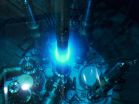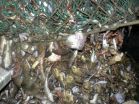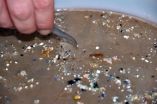(Press-News.org) COLUMBUS, Ohio – Scientists have identified a protein that is essential to the survival of E. coli bacteria, and consider the protein a potential new target for antibiotics.
In the study, the researchers confirmed that this protein, called MurJ, flips a fatty molecule from one side of a bacterial cell membrane to the other. If that molecule isn't flipped, the cell cannot construct a critical layer that keeps pressurized contents of the cell contained. If those contents aren't contained, the cell bursts.
E. coli is part of the gram-negative family of bacteria, characterized by having an extra membrane, called the outer membrane, that reduces the chances for a drug to penetrate the cell to kill it. Inhibiting MurJ, however, would require getting past just one of the two membranes, meaning it could be an attractive new target for antibiotics in this age of resistant pathogens.
"We have proof of principle that MurJ is actually a valid target because we showed that if we stop it from working, the cells will die within 10 minutes – very quickly," said Natividad Ruiz, assistant professor of microbiology at The Ohio State University and a co-lead author of the study.
"If you want to develop an antibiotic, it's important to know a protein's function. Defining the activity associated with MurJ is a big step forward toward possibly designing antibiotics that could target it."
Ruiz co-led the study with Thomas Bernhardt, associate professor of microbiology and immunobiology at Harvard Medical School. The research is published in the July 11, 2014, issue of the journal Science.
This work zeroes in on trying to stop construction of a bacterial cell layer called peptidoglycan, a mesh-like structure that, in gram-negative bacteria like E. coli, rests between the inner and outer cell membranes. Without this layer, E. coli cells can't survive.
Scientists have long known most of the steps behind the creation of this layer, which consists of sugars and amino acids cross-linked with each other. But one detail has remained elusive: which protein could get a specific lipid required for building the peptidoglycan layer to change its location, from the inside of the inner membrane to the outside of that membrane, where the peptidoglycan construction is under way.
Lipids contain fat and other substances and serve as part of a cell membrane's infrastructure. The mystery protein has been referred to as a flippase because of its function: flipping the lipid.
About 25 years ago, other groups of scientists proposed two likely proteins that fulfilled this role based on their locations in the bacterial cell. The proteins were known to contribute to construction of the peptidoglycan, but their specific function was never demonstrated.
While investigating cell membranes as a postdoctoral researcher, Ruiz narrowed in on the potential of the MurJ protein to serve as the E. coli flippase.
Ruiz and colleagues have previously shown that MurJ has several features that point to this possibility: A model of its structure shows the characteristic cavity that a flippase needs to have; eliminating the protein showed that cells wouldn't make the peptidoglycan layer; and it was demonstrated to be related to other flipping proteins.
In this new work, the labs led by Ruiz and Bernhardt combined to take the additional steps needed to confirm MurJ's function.
One step that was important to Ruiz was being able to stop MurJ's work in the cells and see the immediate effects of that inhibition. With most research like this, scientists lower protein levels by suppressing activation of the genes that make the protein – which takes time and doesn't necessarily fully eliminate the protein's presence.
Ruiz's lab instead used a synthetic chemical to bind to hotspots on MurJ in cells in ways that immediately stopped the protein from functioning.
"The idea is to inhibit the protein, and then – boom – analyze it and see whether you're stopping the flipping," Ruiz said. "It's the equivalent to using an antibiotic that would kill the protein by not allowing it to work when it binds."
Bernhardt's lab then developed a way to further test the effects of inhibiting MurJ. The researchers used a toxin some cells release that is known to "eat" the flipped lipid shortly after it appears on the outside of its inner membrane, effectively halting construction of the peptidoglycan.
In normal cells, very little of the target lipid could be detected when the toxin was inserted into the cells, meaning the lipid was being flipped and immediately consumed by the toxin. But when MurJ was inhibited in those cells and the toxin was added, the scientists detected a buildup of the lipid that the toxin could not eat – meaning that the lipid never got flipped because the activity of MurJ was gone.
"We showed these cells will die if we inhibit MurJ and we showed that MurJ is required for flipping to occur. If the cells are dying because the flipping doesn't occur, then nobody else is doing that job. This is the one," Ruiz said, explaining that MurJ is the mystery flippase.
INFORMATION:
This research was supported by funds from the American Heart Association and the National Institutes of Health.
Additional co-authors are Lok-To Sham of Harvard Medical School, Emily Butler of Ohio State's Department of Microbiology, and Matthew Lebar and Daniel Kahne of Harvard University.
Contact: Natividad Ruiz, (614) 292-3426; Ruiz.82@osu.edu
Written by Emily Caldwell, (614) 292-8310; Caldwell.151@osu.edu
Study points to potential new target for antibiotics against E. coli, other bugs
Scientists identify protein in bacteria with essential role in survival
2014-07-10
ELSE PRESS RELEASES FROM THIS DATE:
Cultured CTCs reveal genetic profile, potential drug susceptibility of breast cancer cells
2014-07-10
Circulating tumor cells captured with a microchip-based device developed at the Massachusetts General Hospital (MGH) Center for Engineering in Medicine and the MGH Cancer Center can be cultured to establish cell lines for genetic analysis and drug testing. In the July 11 issue of Science, an MGH research team reports that the cultured cells accurately reflect a tumor's genetic mutation over time and changing susceptibility to therapeutic drugs.
"We now can culture cells from the blood that represent those present in metastatic deposits, which allows testing for drug ...
Inherited 'memory' of environmental impact on health may be limited
2014-07-10
When a pregnant mother is undernourished, her child is at a greater than average risk of developing obesity and type 2 diabetes, in part due to so-called 'epigenetic' effects. A new study in mice demonstrates that this 'memory' of nutrition during pregnancy can be passed through sperm of male offspring to the next generation, increasing risk of disease for her grandchildren as well. In other words, to adapt an old maxim, 'you are what your grandmother ate'. The study also raises questions over how epigenetic effects are passed down from one generation to the next – and ...
Researchers harness a powerful new source of up-to-date information on economic activity
2014-07-10
ANN ARBOR--- Researchers at the University of Michigan, University of California Berkeley, and Arizona State University have developed a new data infrastructure for measuring economic activity.
The infrastructure uses aggregated and de-identified data on transactions and account balances from Check, a mobile payments app, to produce accurate and comprehensive measures of consumers' spending and income on a daily basis.
In a paper appearing in the July 11 issue of Science, economists Michael Gelman, Shachar Kariv, Matthew Shapiro, Dan Silverman, and Steven Tadelis ...
International science team solve biological mystery
2014-07-10
This news release is available in German.
An international team of researchers, led by the University of Leicester, has solved a long-standing mystery in biology, by identifying the molecular structure of a vital biological chemical. The debate – which has raged within the scientific community for years – boils down to something as simple as a hydrogen atom: is it there, or is it not?
The controversy centres around a form of enzyme called a heme (or haem, as in haemoglobin) at the centre of which is an iron atom (Fe) called a 'ferryl' which becomes oxidised when ...
Overfishing in the English Channel leaves fisherman scraping the bottom of the barrel
2014-07-10
Decades of overfishing in the English Channel has resulted in the removal of many top predators from the sea and left fishermen 'scraping the barrel' for increasing amounts of shellfish to make up their catch.
Sharks, rays, cod, haddock and many other species at the head of the food chain are at historic lows with many removed from the area completely.
These are some of the findings of a study led by marine biologists at Plymouth University, in association with international non-profit research organization WorldFish. They analysed catches over the past 90 years and found ...
Uncertainty gives scientists new confidence in search for novel materials
2014-07-10
Scientists at Stanford University and the Department of Energy's SLAC National Accelerator Laboratory have found a way to estimate uncertainties in computer calculations that are widely used to speed the search for new materials for industry, electronics, energy, drug design and a host of other applications. The technique, reported in the July 11 issue of Science, should quickly be adopted in studies that produce some 30,000 scientific papers per year.
"Over the past 10 years our ability to calculate the properties of materials and chemicals, such as reactivity and mechanical ...
Scripps scientists discover evidence of super-fast deep earthquake
2014-07-10
As scientists learn more about earthquakes that rupture at fault zones near the planet's surface—and the mechanisms that trigger them—an even more intriguing earthquake mystery lies deeper in the planet.
Scientists at Scripps Institution of Oceanography at UC San Diego have discovered the first evidence that deep earthquakes, those breaking at more than 400 kilometers (250 miles) below Earth's surface, can rupture much faster than ordinary earthquakes. The finding gives seismologists new clues about the forces behind deep earthquakes as well as fast-breaking earthquakes ...
Leading scientists express rising concern about 'microplastics' in the ocean
2014-07-10
Microplastics – microscopic particles of plastic debris – are of increasing concern because of their widespread presence in the oceans and the potential physical and toxicological risks they pose to organisms.
This is the view of two of the world's most eminent authorities on the subject, Professor Kara Lavender Law, of Sea Education Association (Woods Hole, MA), and Professor Richard Thompson of Plymouth University (UK).
In an article published today in the journal Science, the two scientists have called for urgent action to "turn off the tap" and divert plastic waste ...
Control strategy for Dengue, malaria increases risk of West Nile virus
2014-07-10
Mosquitoes infected with the bacteria Wolbachia are more likely to become infected with West Nile virus and more likely to transmit the virus to humans, according to a team of researchers.
"Previous research has shown that Wolbachia -- a genus of bacteria that live inside mosquitoes -- render mosquitoes resistant to pathogen infection, thereby preventing the mosquitoes from infecting humans with the pathogens," said Jason Rasgon, associate professor of entomology, Penn State. "As a result, researchers are currently releasing Wolbachia-infected mosquitoes into the wild ...
New study shows drinking alcohol provides no heart health benefit
2014-07-10
PHILADELPHIA – Reducing the amount of alcoholic beverages consumed, even for light-to-moderate drinkers, may improve cardiovascular health, including a reduced risk of coronary heart disease, lower body mass index (BMI) and blood pressure, according to a new multi-center study published in The BMJ and co-led by the Perelman School of Medicine at the University of Pennsylvania. The latest findings call into question previous studies which suggest that consuming light-to-moderate amounts of alcohol (0.6-0.8 fluid ounces/day) may have a protective effect on cardiovascular ...
LAST 30 PRESS RELEASES:
Numbers in our sights affect how we perceive space
SIMJ announces global collaborative book project in commemoration of its 75th anniversary
Air pollution exposure and birth weight
Obstructive sleep apnea risk and mental health conditions among older adults
How talking slows eye movements behind the wheel
The Ceramic Society of Japan’s Oxoate Ceramics Research Association launches new international book project
Heart-brain connection: international study reveals the role of the vagus nerve in keeping the heart young
Researchers identify Rb1 as a predictive biomarker for a new therapeutic strategy in some breast cancers
Survey reveals ethical gaps slowing AI adoption in pediatric surgery
Stimulant ADHD medications work differently than thought
AI overestimates how smart people are, according to HSE economists
HSE researchers create genome-wide map of quadruplexes
Scientists boost cell "powerhouses" to burn more calories
Automatic label checking: The missing step in making reliable medical AI
Low daily alcohol intake linked to 50% heightened mouth cancer risk in India
American Meteorological Society announces Rick Spinrad as 2026 President-Elect
Biomass-based carbon capture spotlighted in newly released global climate webinar recording
Illuminating invisible nano pollutants: advanced bioimaging tracks the full journey of emerging nanoscale contaminants in living systems
How does age affect recovery from spinal cord injury?
Novel AI tool offers prognosis for patients with head and neck cancer
Fathers’ microplastic exposure tied to their children’s metabolic problems
Research validates laboratory model for studying high-grade serous ovarian cancer
SIR 2026 delivers transformative breakthroughs in minimally invasive medicine to improve patient care
Stem Cell Reports most downloaded papers of 2025 highlight the breadth and impact of stem cell research
Oxford-led study estimates NHS spends around 3% of its primary and secondary care budget on the health impacts of heat and cold in England
A researcher’s long quest leads to a smart composite breakthrough
Urban wild bees act as “microbial sensors” of city health.
New study finds where you live affects recovery after a hip fracture
Forecasting the impact of fully automated vehicle adoption on US road traffic injuries
Alcohol-related hospitalizations from 2016 to 2022
[Press-News.org] Study points to potential new target for antibiotics against E. coli, other bugsScientists identify protein in bacteria with essential role in survival


